Outdoor lighting management for industrial enterprises
Supply of outdoor lighting installations
All external lighting of industrial enterprises is divided according to their purpose into lighting of roads and alleys, workplaces, warehouses for various materials and finished products, platforms for unloading and loading goods. Security lighting is arranged along the borders of the protected areas.
Floodlights and lamps are powered by the common power network of the illuminated object.
Individual parts of the lighting installation can be powered by different transformer substations or distribution points. Therefore, the number of food stores can be quite large, but the control of the entire outdoor lighting installation must be, in accordance with the current rules and regulations, centralized - from one or possibly a minimum number of places. Manual and automatic control types can be used only as additional ones to provide more comfortable working conditions.
The mode of operation in individual zones on the territory of the objects is different, which requires a different mode of operation of the lighting installations of these zones. For example, in the absence of work on the storage areas, their lighting is turned off, and the road lighting on the territory of the facility must remain on at this time. Therefore, the outdoor lighting control system must provide the possibility of separate control of the individual parts of the lighting installation.
Outdoor lighting control schemes for industrial enterprises
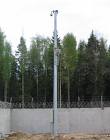 Consider some options for managing outdoor lighting in industrial plants and various other facilities.
Consider some options for managing outdoor lighting in industrial plants and various other facilities.
For example, the illuminated area is small and the outdoor lighting network is fed by one or two transformer or distribution substations. In this case, a separate line or separate lines are allocated to the panels of these substations to feed the outdoor lighting network, and control is carried out directly from these panels with the help of devices installed on them (automatic machines, knife switches or packet switches).
With a large number of lighting fixtures, when three-phase networks are used to power them, it is rational to install not three-pole control devices, but single-pole ones. This allows the external lighting to be switched on and off in parts. At night, one phase, i.e. one third of the total number of lamps can be left on as "backup" lighting. When distributing, dividing all lighting fixtures into phases, the most necessary lighting fixtures must be connected to the "standby" phase, for example, at road junctions, at dangerous turns, etc.You can provide, if necessary, switching of one phase to an independent source of electricity.
In larger installations, where outdoor lighting is supplied by many substations, contactors are installed in each of them on the outdoor lighting lines instead of direct control devices or magnetic starters and their coils are connected to a dedicated control network or to an external lighting network in a cascaded scheme.
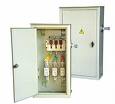 Implement complex systems and remote control equipment rationally only in those facilities where there are equipped television installations for control power supply or various technological processes and the lighting control system is an integral part of the overall control system.
Implement complex systems and remote control equipment rationally only in those facilities where there are equipped television installations for control power supply or various technological processes and the lighting control system is an integral part of the overall control system.
Security lighting fixtures or searchlights are installed along the boundaries of the protected site. Security lighting control should be centralized — from the control point for all exterior lighting or from the guardhouse. In some cases, for example, when lighting approaches guarded places or other objects, local control is organized — directly from the location of the guard. This gives the guard the ability to turn the security lighting on or off himself, depending on the specific conditions.
For this purpose, it is not necessary to connect power lines to the security posts and install switches or switches on them; in some cases it is easier to bring only the start button of the remote control to the location of the security post. Therefore, the security lighting control system must be closely related to the overall tactical plan for the protection of the illuminated object.
On the territory of each enterprise there are many lamps installed at the entrances of buildings. These luminaires, usually connected to the interior lighting network, must have separate switches and be controlled independently of the interior lighting fixtures. With a large number of them, they can be separated into a separate group and controlled together with external lighting.
Spotlight control
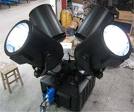 Projector lighting is widely used to illuminate outdoor spaces. Depending on the size and nature of the illuminated area, masts with a height of 10-50 m are used. The number of floodlights installed on each of them is different: on masts with a height of 10 m, the number of floodlights rarely exceeds 10, on masts with a height of 15 -30 m usually 15-25 floodlights, and at 50 m high masts the number of floodlights reaches 100, for example, in sports stadiums.
Projector lighting is widely used to illuminate outdoor spaces. Depending on the size and nature of the illuminated area, masts with a height of 10-50 m are used. The number of floodlights installed on each of them is different: on masts with a height of 10 m, the number of floodlights rarely exceeds 10, on masts with a height of 15 -30 m usually 15-25 floodlights, and at 50 m high masts the number of floodlights reaches 100, for example, in sports stadiums.
Depending on the number of projectors and mainly on the required mode of their operation, a control scheme is selected. With a small number of floodlights on masts with a height of 10 - 15 m, in some cases all floodlights are controlled simultaneously. For this purpose, single-feed boxes, for example YARV or YAVP type boxes, with a switch and fuses are installed. If necessary, a remote control is installed instead of NRV and JVP magnetic switch.
Slightly different management of masts with a large number of spotlights. To ensure the possibility (turning on the spotlights in parts, as well as to increase the reliability of their work, the entire number of spotlights is divided into separate groups of two or three spotlights connected to the shield or shields. Repair work on the mast at night, without turning off all projectors.Also, in the event of a short circuit in one of the projectors or in the cable, only projectors from one group are turned on.
It is recommended to connect the floodlights to the mains via plug connections. In addition to the group panels, an input panel with a switch or starter is also installed on the masts to enable remote control of all floodlights from a central control center.
On masts that have several places, the shields for distribution groups are installed not in the lower part of the mast, but in places where the searchlights are located. At the bottom of the mast are mounted an input board with a remote control starter and a main board whose lines feed the upper distribution boards.
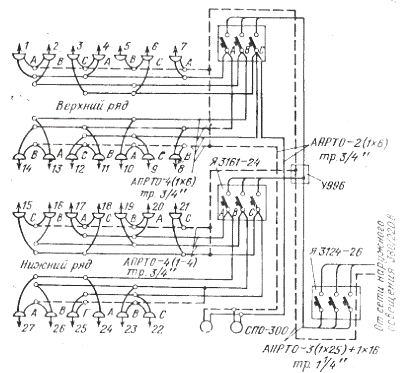 Scheme of switching on and controlling floodlights on a 28 m high mast
Scheme of switching on and controlling floodlights on a 28 m high mast
If there are sentries or photoelectric automata on the searchlight masts, their executive relay is turned on in series with the coil of the input starters of the mast. To ensure the safety of aircraft flights, all high-rise buildings (above 50 m in height) must have adequate safety lights.
The lighting fixtures are powered and controlled independently of the rest of the outdoor lighting network. Safety lights must be turned on at night, as well as in poor visibility (fog, snow, etc.).
YAUO-9600 Series Lighting Control Boxes
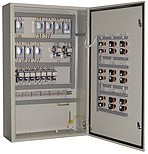 YAU-9600 lighting control boxes are designed for automatic, local, manual or remote control of lighting networks and installations of industrial buildings, territories of any objects with any light sources.
YAU-9600 lighting control boxes are designed for automatic, local, manual or remote control of lighting networks and installations of industrial buildings, territories of any objects with any light sources.
Lighting control boxes provide:
-
Switching on and off the lighting installation by the photosensor signal when the specified level of illumination is reached;
-
Turning on and off the lighting installation in certain periods of time (for example, during technological breaks in the workshop) according to programs set by the mode timer (only scheme YUO 9601);
-
Manual switching on and off of the lighting installation using buttons mounted on the doors of the box;
-
Switching on and off the lighting installation using telemechanical devices from the dispatching points of the energy services.
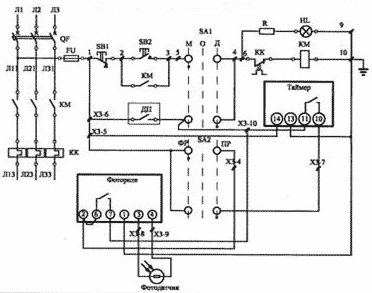 Schematic of the YAUO-9600 lighting control box
Schematic of the YAUO-9600 lighting control box
SHUO lighting control cabinet
The ShUO type lighting control cabinets are designed for automatic, manual, local or remote (from the control room) control of lighting networks and installations of industrial buildings, structures, areas of objects with any light sources with a voltage of 380 V AC with a frequency 50 Hz, as well as for the measurement and distribution of electrical energy, protection of lines in case of overload and short circuit, as well as infrequent switching on and off operation (no more than 6 per hour) of electrical circuits.
The cabinets are designed for external or internal installation with one-way service. The rated operating mode is continuous.
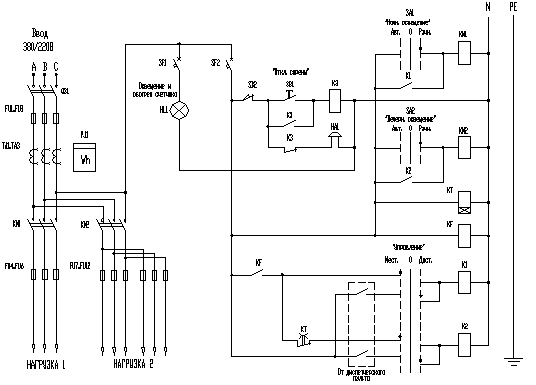 Schematic of SHUO lighting control cabinet
Schematic of SHUO lighting control cabinet
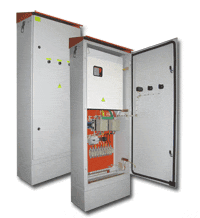 ShUO cabinets can work in the following modes: local, remote, manual and automatic control. Control modes are selected using the appropriate controls.
ShUO cabinets can work in the following modes: local, remote, manual and automatic control. Control modes are selected using the appropriate controls.
SHUO cabinets provide separate control of night lighting (3 single-phase lines) and additional evening lighting (3 single-phase lines, in panels up to 100A and 6 single-phase lines-in panels up to 250A inclusive).
The internal lighting of the cabinet is intended to be switched on with a 40 W incandescent lamp; also used for counter heating in the cold season.
Outdoor lighting control cabinets UNO
Outdoor lighting control cabinets, type UNO * 7001 are intended for automatic, local, manual or remote (from the control room) control of lighting networks and installations of industrial buildings, structures, areas of objects with any light sources (incandescent lamps wire, DRL, DRN, fluorescent, etc.) Voltage of 380 V AC with a frequency of 50 Hz, as well as for measuring and distributing electrical energy, protecting lines in case of overload and short circuit, as well as infrequent switching on and off during operation (no more than 6 times per hour) on electrical circuits.
Cabinets can work in the following control modes:
- Local (autonomous) automatic control (by timer, astronomical clock or by any other driver);
- cascade automatic control of 220V, 50Hz voltage supplied through a special signal wire (telephone pair) from the previous cascade cabinet or TC-TU console;
- local government.
The selection of control modes is made using the appropriate controls: The cabinets provide separate control of night lighting (3 single-phase lines) and additional evening lighting (3 single-phase lines, on panels up to 100A and 6 on panels up to and including 250A).It is possible to turn on the interior lighting of the cabinet with a 40-60 W incandescent lamp and turn on the 220 V socket.
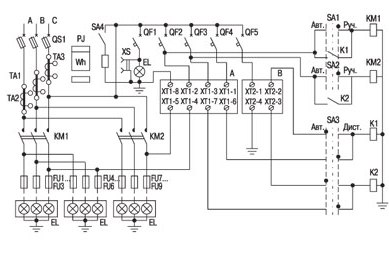 Schematic of the UNO outdoor lighting control cabinet
Schematic of the UNO outdoor lighting control cabinet
